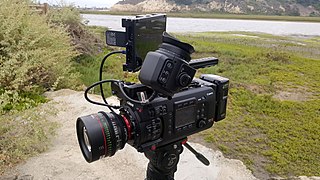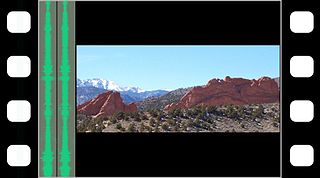
IMAX is a proprietary system of high-resolution cameras, film formats, film projectors, and theaters known for having very large screens with a tall aspect ratio and steep stadium seating.

A movie camera is a type of photographic camera that rapidly takes a sequence of photographs, either onto film stock or an image sensor, in order to produce a moving image to display on a screen. In contrast to the still camera, which captures a single image at a time, the movie camera takes a series of images by way of an intermittent mechanism or by electronic means; each image is a frame of film or video. The frames are projected through a movie projector or a video projector at a specific frame rate to show the moving picture. When projected at a high enough frame rate, the persistence of vision allows the eyes and brain of the viewer to merge the separate frames into a continuous moving picture.
Negative pulldown is the manner in which an image is exposed on a film stock, described in the number of film perforations spanned by an individual frame. It can also describe the orientation of the image on the negative, whether it is captured horizontally or vertically. Changing the number of exposed perforations allows a cinematographer to change both the aspect ratio of the image and the size of the area on the film stock that the image occupies.

The Arri Group is a German manufacturer of motion picture film equipment. Based in Munich, the company was founded in 1917. It produces professional motion picture cameras, lenses, lighting and post-production equipment. Hermann Simon mentioned this company in his book Hidden Champions of the 21st Century as an example of a "hidden champion". The Arri Alexa camera system was used to film Academy Award winners for Best Cinematography including Hugo, Life of Pi, Gravity, Birdman, The Revenant and 1917.

Digital cinematography is the process of capturing (recording) a motion picture using digital image sensors rather than through film stock. As digital technology has improved in recent years, this practice has become dominant. Since the mid-2010s, most movies across the world are captured as well as distributed digitally.

Techniscope or 2-perf is a 35 mm motion picture camera film format introduced by Technicolor Italia in 1960. The Techniscope format uses a two film-perforation negative pulldown per frame, instead of the standard four-perforation frame usually exposed in 35 mm film photography. Techniscope's 2.33:1 aspect ratio is easily enlarged to the 2.39:1 widescreen ratio, because it uses half the amount of 35 mm film stock and standard spherical lenses. Thus, Techniscope release prints are made by anamorphosizing and enlarging each frame by a factor of two.
BNCR is a lens mount developed by Mitchell for use with its reflex 35 mm movie cameras. It was an update of the BNC mount done to accommodate the reflex viewer in the later cameras. BNC mount lenses cannot be used in reflex Mitchell cameras as their shorter back-focus will hit and damage the reflex viewer, which, in various versions, was a pellicle mirror or a rotating mirror. The initials stand for Blimped Newsreel Camera Reflex, which meant that it is a 35 mm camera originally intended for news reporting but included a blimp housing for sound stage shooting plus a reflex viewer to allow the camera operator to view the action through the lens while filming. The reflex option was only added in 1967, while the blimp option - thereby converting an NC into a BNC, - was available at the camera's introduction in 1934, but only a few BNC examples were made before the onset of WW-II, during which manufacture of "production" cameras was suspended.

Ultra Panavision 70 and MGM Camera 65 were, from 1957 to 1966, the marketing brands that identified motion pictures photographed with Panavision's anamorphic movie camera lenses on 65 mm film. Ultra Panavision 70 and MGM Camera 65 were shot at 24 frames per second (fps) using anamorphic camera lenses. Ultra Panavision 70 and MGM Camera 65's anamorphic lenses compressed the image 1.25 times, yielding an extremely wide aspect ratio of 2.76:1.

Codex Digital creates digital production workflow tools for motion pictures, commercials, independent films, and TV productions.
Moviecam is a motion picture equipment company specializing in movie camera systems for 35 mm film.
Arricam is a 35 mm movie camera line manufactured by Arri.
This article summarized the comparison of movie cameras.
The Arriflex 35, released by Arri in 1937, was the first reflex 35mm production motion picture camera.

Anamorphic format is the cinematography technique of shooting a widescreen picture on standard 35 mm film or other visual recording media with a non-widescreen native aspect ratio. It also refers to the projection format in which a distorted image is "stretched" by an anamorphic projection lens to recreate the original aspect ratio on the viewing screen. The word anamorphic and its derivatives stem from the Greek anamorphoun, compound of morphé with the prefix aná. In the late 1990s and 2000s, anamorphic lost popularity in comparison to "flat" formats such as Super 35 with the advent of digital intermediates; however, in the years since digital cinema cameras and projectors have become commonplace, anamorphic has experienced a considerable resurgence of popularity, due in large part to the higher base ISO sensitivity of digital sensors, which facilitates shooting at smaller apertures.

The Arriflex 535 is a movie camera product line created by Arri in 1990 to replace the Arriflex 35 BL line.
Moviecam SL is a movie camera product line created by Moviecam in 1996. It is a lighter version of Moviecam Compact. It can use most of the same accessories as Moviecam Compact but allows for even easier shooting from the shoulder or with a support like Steadicam systems.

The Arri Alexa is a digital motion picture camera system developed by Arri. First introduced in April 2010, the camera was Arri's first major transition into digital cinematography after previous efforts such as the Arriflex D-20 and D-21.

The Blackmagic Cinema Camera is a digital movie camera developed and manufactured by Blackmagic Design and released on September 4, 2012. It is part of the Cinema Camera family of digital movie cameras and shoots 2.5K video in raw, Apple ProRes, CinemaDNG and Avid DNxHD formats.
The Arriflex 235 is a lightweight 35mm MOS movie camera released in 2003 by ARRI.
The Arriflex 765 is a 65 mm movie camera created by Arri in 1989.










